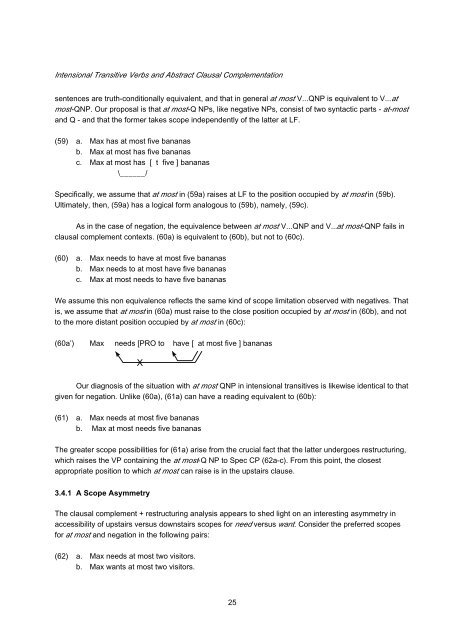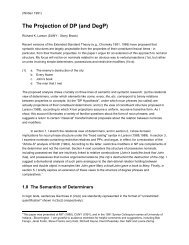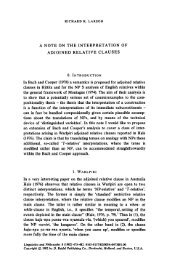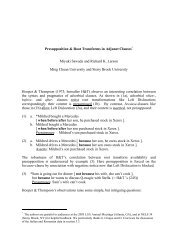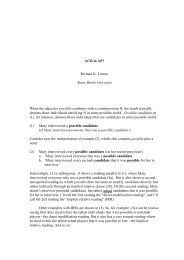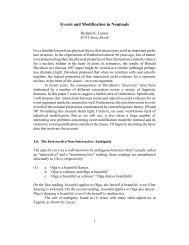Intensional Transitive Verbs and Abstract Clausal Complementation
Intensional Transitive Verbs and Abstract Clausal Complementation
Intensional Transitive Verbs and Abstract Clausal Complementation
You also want an ePaper? Increase the reach of your titles
YUMPU automatically turns print PDFs into web optimized ePapers that Google loves.
<strong>Intensional</strong> <strong>Transitive</strong> <strong>Verbs</strong> <strong>and</strong> <strong>Abstract</strong> <strong>Clausal</strong> <strong>Complementation</strong><br />
sentences are truth-conditionally equivalent, <strong>and</strong> that in general at most V...QNP is equivalent to V...at<br />
most-QNP. Our proposal is that at most-Q NPs, like negative NPs, consist of two syntactic parts - at-most<br />
<strong>and</strong> Q - <strong>and</strong> that the former takes scope independently of the latter at LF.<br />
(59) a. Max has at most five bananas<br />
b. Max at most has five bananas<br />
c. Max at most has [ t five ] bananas<br />
\______/<br />
Specifically, we assume that at most in (59a) raises at LF to the position occupied by at most in (59b).<br />
Ultimately, then, (59a) has a logical form analogous to (59b), namely, (59c).<br />
As in the case of negation, the equivalence between at most V...QNP <strong>and</strong> V...at most-QNP fails in<br />
clausal complement contexts. (60a) is equivalent to (60b), but not to (60c).<br />
(60) a. Max needs to have at most five bananas<br />
b. Max needs to at most have five bananas<br />
c. Max at most needs to have five bananas<br />
We assume this non equivalence reflects the same kind of scope limitation observed with negatives. That<br />
is, we assume that at most in (60a) must raise to the close position occupied by at most in (60b), <strong>and</strong> not<br />
to the more distant position occupied by at most in (60c):<br />
(60a’) Max needs [PRO to have [ at most five ] bananas<br />
X<br />
Our diagnosis of the situation with at most QNP in intensional transitives is likewise identical to that<br />
given for negation. Unlike (60a), (61a) can have a reading equivalent to (60b):<br />
(61) a. Max needs at most five bananas<br />
b. Max at most needs five bananas<br />
The greater scope possibilities for (61a) arise from the crucial fact that the latter undergoes restructuring,<br />
which raises the VP containing the at most-Q NP to Spec CP (62a-c). From this point, the closest<br />
appropriate position to which at most can raise is in the upstairs clause.<br />
3.4.1 A Scope Asymmetry<br />
The clausal complement + restructuring analysis appears to shed light on an interesting asymmetry in<br />
accessibility of upstairs versus downstairs scopes for need versus want. Consider the preferred scopes<br />
for at most <strong>and</strong> negation in the following pairs:<br />
(62) a. Max needs at most two visitors.<br />
b. Max wants at most two visitors.<br />
25


